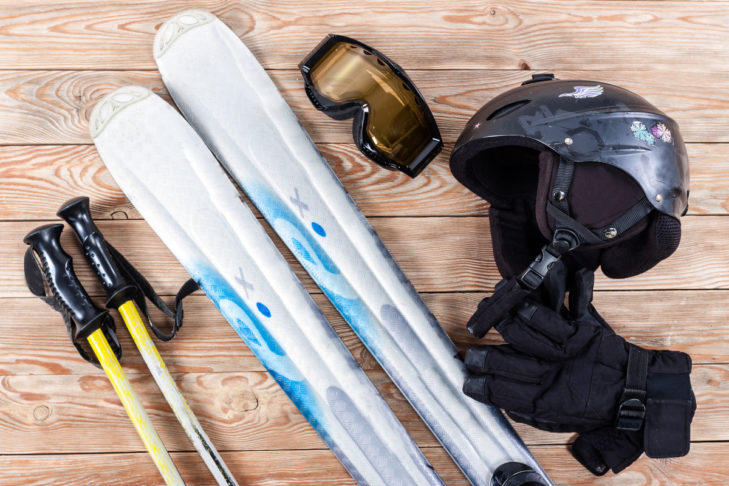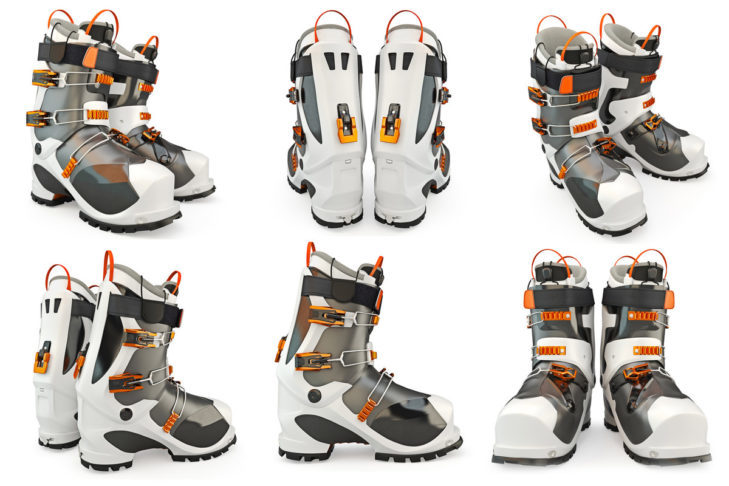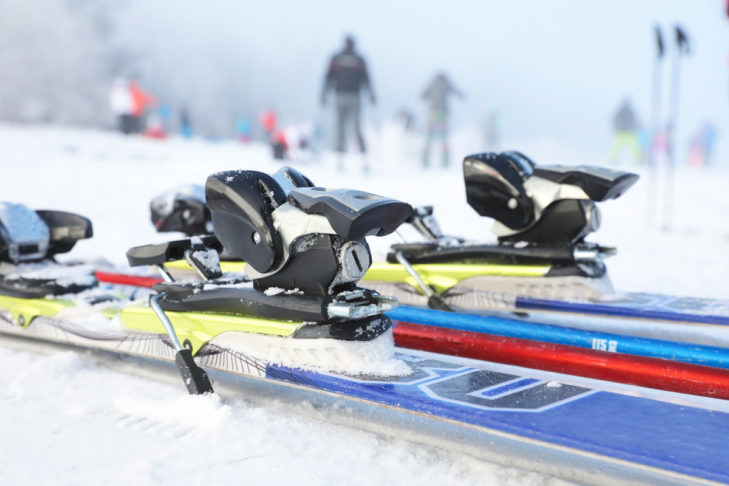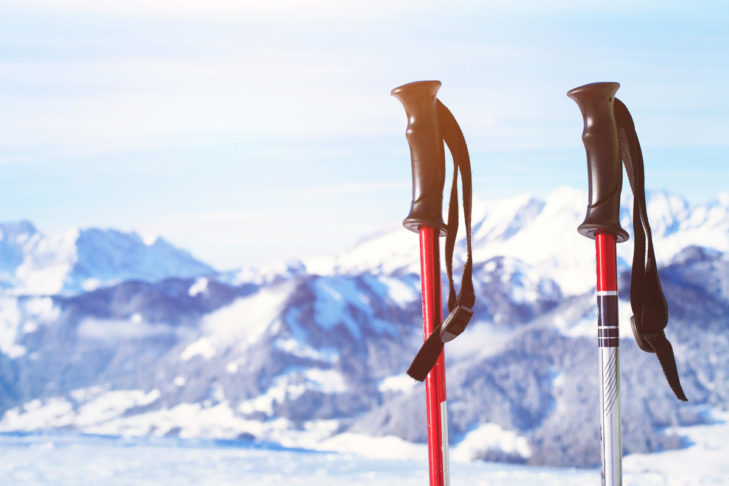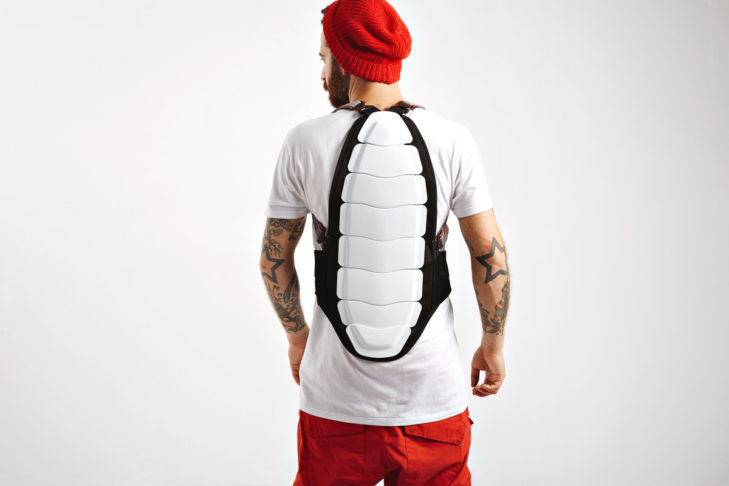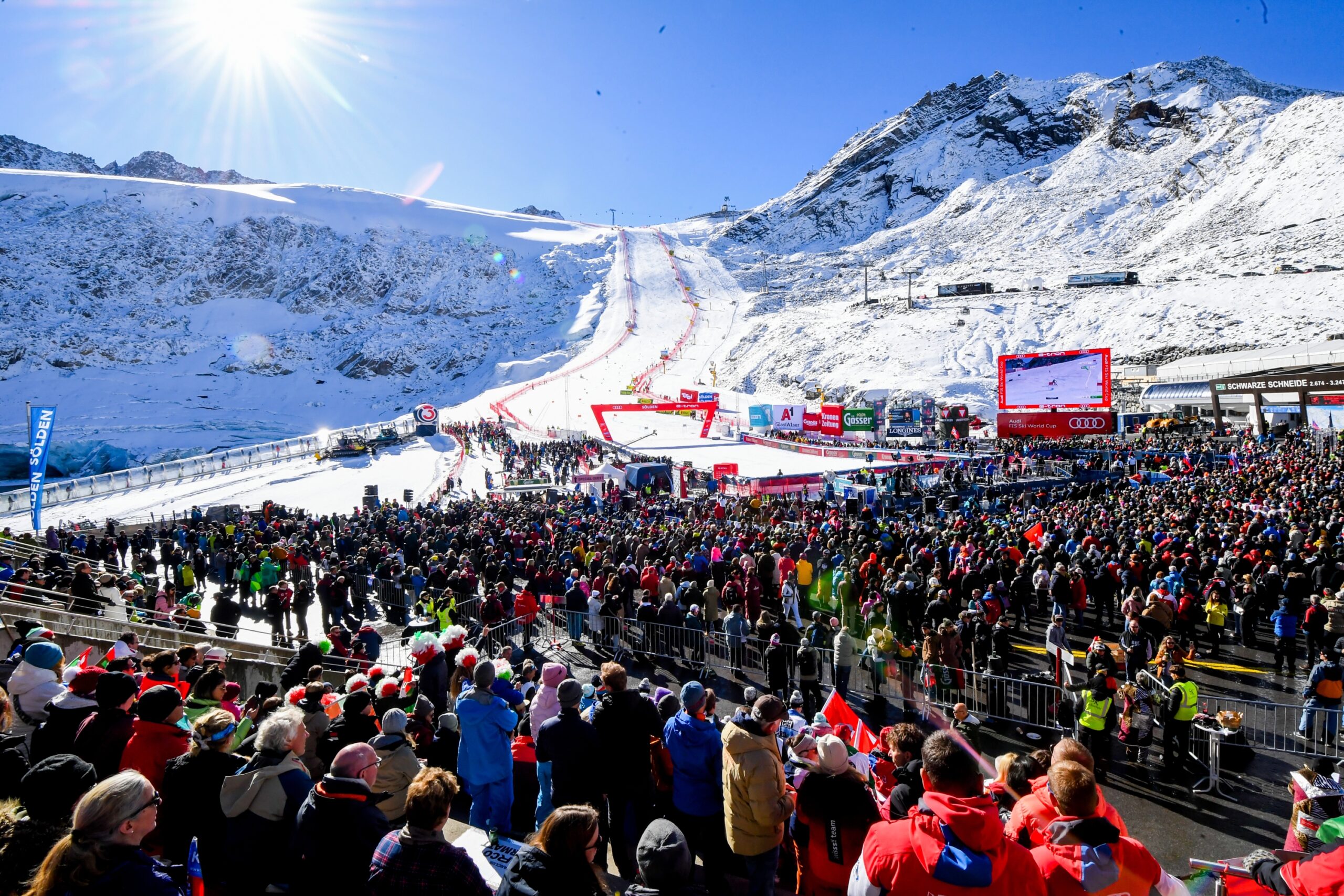It’s not easy choosing the right ski equipment. Depending on level of skill, preference, functionality or type of skier, there is a large number of models and manufacturers for every part of the equipment. This small lesson in ski equipment explains how the individual parts of equipment work, and what is important when choosing the right equipment.
It all starts with the right ski
Of course the basis for every ski equipment is the right ski. However, choosing the right one is easier said than done: depending on the type of ski and level of skill, there is now a large selection of skis to choose from. In order for you to find the right one it helps to understand the structure: a ski consists of several layers as well as side edges, tips and ends. The construction of these parts influences what a ski can do and for whom it is suitable.
Rigidity
The ski’s rigidity is determined by two parameters, flex and torsion. “Flex” is the lengthwise rigidity, i.e. how much a ski bends when a certain pressure is exerted on the ski by weight and speed. A hard flex offers more control and a smoother riding style. The torsion, on the other hand, refers to the rigidity along the longitudinal axis, i.e. the angle at which the ski is positioned when it edges towards the snow. A soft torsion does not edge as strongly as a hard one, which forgives more mistakes. How rigid or soft a ski has to be depends on the body weight, ability and preferences of the respective skier.
Running surface
The ski’s running surface is the lowest part of the ski which has direct contact to the snow when skiing. This is why it is important to wax it well at all times. A waxed ski glides better and is also better protected. Typically, the coating consists of polyethylene plastics, which give the ski different properties depending on the material composition. The running surface material can influence e.g. how fast the ski is and how much wax it can absorb.
Edges
The edges are on the two outer sides of the ski and they are made of metal, mostly steel. The side edges are pre-ground at a certain angle, which, for most skis, is between 88 and 90 degrees in relation to the surface, depending on the intended use. This angle influences the running behaviour of the skis. In fact, a minimal change of the angle has a big effect on the skiing style: the flatter the angle, the harder it is to control the ski. The edges should be ground regularly.
Construction radius
If you take a close look at the course of the ski’s side edge, you will notice that the skis area narrower in the middle than they are at the shovel and at the end. The edge follows this shape at the outside of the ski, forming an almost circular arc. This is indicated by a certain radius, the so called construction radius. In practice, this means that the ski makes a curve in exactly this radius when it edges up. Depending on the ski type, the skis may have a different construction radius. The smaller the radius, the smaller and narrower the curves you can ski can be. The larger the radius, the wider are the curves you can ski.
| Radius (in m) | Type of ski | Description |
|---|---|---|
| 10 – 12 | Slalom | These skis can take small, aggressive curves. |
| 14 – 20 | Freestyle, Beginner, All-rounder, Powder snow | Most skis are within this range. The larger radius gives them more stability at higher speeds, and they are suitable for most speeds and slopes. |
| 20 – 30 | Giant Slalom, Freestyle, Powder snow | As the Giant Slalom requires faster skiing and wider curves, the radius must be larger. Freestyle skis and skis for powder snow usually also have a bigger construction radius as they are not used for fast, aggressive curves. |
| 30+ | Racer | Skis with a radius of 30 or more metres are almost exclusively intended for racers riding at extremely high speeds. For most slopes, however, such a wide curve is too dangerous. |
Width
A ski can be built wider or narrower. The width affects how the ski glides through the snow and how much pressure you can exert on the edges. For example, skis designed for powder snow are wider. This gives you a larger surface area, exerts less pressure on the snow and makes the ski glide more smoothly. At the same time, a wide ski also makes edging more difficult. This is why the general tendency is to build general-purpose skis which are wide enough to be suitable for both prepared and off-piste slopes.
Length
The length of the ski depends on the type of ski and the size of the skier. A long ski offers more control when skiing at high speeds – however, it limits the mobility and agility.
Weight
A heavy ski offers more control, but makes it harder to manoeuvre it. Beginners and freestylers will therefore mainly use lighter skis, which makes them more agile. Racer-skiers prefer heavier skis, which gives them more control at high speeds.
Ski tips
Traditionally, the front tips (“the shovel”) of a ski are more curved than the ends. This makes it easier to ski over hills. Freestyle skiing has also established curved ends, as skiers also ride “fakie”, i.e. they ski backwards down the slope.
Types of skis
There are special types of skis, depending on skill and the type of skiing:
All-rounders are, as the name suggests, suitable for many different terrains and levels. Therefore, if you ski on many different types of slopes, you will usually use all-rounder skis.
For beginners there are special beginner skis, which are a little shorter and lighter than all-rounders. This gives the skiers more stability and agility at the beginning.
With the growing popularity of off-piste skiing, specific powder snow skis or freeride skis have also been developed. These are wider and longer in order to make gliding easier on very soft snow.
Furthermore, there are special types of skis for professional skiers, such as e.g. slalom, giant slalom and downhill.
Ski boots provide the feel-good factor
As important as the skis are for the equipment, they are of course not the only component. The boots also have a very important part in skiing. Because no matter how perfect the skis may be, anyone standing in an uncomfortable ski boot will have no fun on the slopes.
Moreover, the boots protect the lower legs and ankles, and they transfer the movements to the skis. This is why ski boots feel harder and less flexible than normal shoes. This is mainly due to the hard outer shell of the boots. It is made of polymer plastic and can be more or less soft and flexible, depending on the degree of flex. The flex ranges from 50 to 140 +, taking into account that a lower flex stands for softer, more flexible shoes. However, the flex-scale can vary depending on the manufacturer, which means that it only serves as a matter of orientation. After all, one has to try out the boots – 20 to 30 minutes is ideal – and best get advice from a retailer to find the best model.
Not only the flex degree, but also the form of the outer shell influences how comfortable the boot feels. The cover can be more or less flexbile, depending on the material and design. How flexible and stretchy a boot should be depends on the type of ski. Freestylers, for example, require more flexibility, beginners need more protection. However, the following applies: the sportier the skiing style and the heavier the skier, the harder the ski boot (higher flex value).
Apart from the outer form of the boot there are also differences on the inside of the ski boot. For example, a thicker material provides more warmth, neoprene gives more flexibility and a thinner material intensifies the transmission of movements.
Bindings are the “middle man” between ski and ski-boot
Not only the boots, but also the bindings are important when it comes to the transmission of movements. The bindings are obviously the connection between boot and ski. They ensure that the boot remains firmly attached to the ski. However, they also have a mechanism that ensures that the boot is released from the binding in the event of a fall, so that you do not injure yourself. The type of binding used depends on the sole of the ski boot, the weight and size of the skier as well as on the type of ski.
Every binding has two brakes. As soon as the boot is released from the binding, the brakes are extended and make sure the ski does not slip away. When the boots snap into place in the binding, the brake is deactivated.
However, every binding is not the same. There are different bindings for children and adults. Aside from that, you can also notice differences in quality depending on the material, because higher quality materials improve strength, resilience, durability and force transmission. These properties are usually not as important for beginners, which is why more experienced skiers will invest in more expensive bindings.
There are also special bindings for off-piste skiing, which allow skiers to both climb up and ski down the mountain.
Ski poles provide more balance and the right rhythm
While bindings, shoes and skis form the basis of the equipment, the poles are important auxiliary equipment. The poles allow winter sports enthusiasts to push themselves over flat terrain, they help with the balance, and with the poles you set the pace of the descent, especially during short turns.
When choosing the poles, their length is the most important aspect. The length depends on the size of the skier as well as on the type of skiing. Ski poles are measured from the upper part of the grip to the end of the tip. When buying ski poles it is important to remember that you are up to 5 cm taller with skis and ski boots. In order to find the ideal length, it is best to grip the ski pole the other way around – i.e. the part that is normally in the snow.
Ski poles consist of a handle, loops, the stick, tips and plates. The handle is usually made of plastic and a foamy cover that makes holding the poles safe and comfortable. There are many different types of handles. It is best to try a few and choose the ones that feel most comfortable and stable in the hand.
The loops come around the wrists and make sure you don’t lose your ski poles. Furthermore, you do not have to hold the grip with so much pressure anymore. This relieves and protects the wrist.
The stick is either made of aluminium or carbon fibre. Aluminium is more robust, carbon fibre, on the other hand, allows for a little more flexibility. In most cases the stick is straight, but there are also curved ones. These are specially designed for professional skiers who want to fit the poles to the body in a certain way in order to generate more aerodynamics and less air resistance.
The tips are at the end of the stick. They hold the poles in the snow – above them are the “plates”, the discs at the end of the pole, which make sure the pole does not sink too deeply into the snow. Here, too, you will find differences: plates with a wider radius do not sink as much into the snow, which is why they are preferred to be used in powder snow. Racers, on the other hand, prefer plates with a small radius because these offer less resistance.
Shorter ski poles have been established in freestyle skiing. This is because freestyle skiers hardly need the poles and because the poles hinder their tricks if they are too long.
Safe on the piste with helmet and protectors
Apart from the classic ski equipment, special safety features for skiers have also become increasingly important as part of the equipment in recent years. These include the helmet and protectors:
Helmet
A helmet absorbs the impact of a fall and distributes the shock wave so that the head is optimally protected against injuries.
Since helmets are becoming more and more popular, some manufacturers have started equipping them with additional functions. These include ventilation shafts for the best possible cooling, ear protectors, as well as high-tech functions such as a Bluetooth connection to a mobile phone, which allows you to communicate with other skiers in the group, or even to listen to music.
Most important about a helmet, however, is not so much its design as is its safety. As all helmets underlie an international safety standard it is mainly about details. Those needing particularly much protection can even choose a helmet with a complete face and chin protection.
Protectors
Protectors are protective pads that keep skiers from injuries in the event of a fall. A back protector lies around the spine to that it acts like a shell. By now, there are also protector jackets with a built-in back protector one can wear under the ski jacket.
Some skiers use padded trousers which protect thighs, hip and tailbone in the event of a fall. This makes falling softer and less painful especially on icy underground.
Apart from that there are also elbow and knee protectors. As those usually limit the mobility, only few skiers use them.
It’s all about the right care
Even the best equipment does not help at all when it is not maintained well enough. Part of the maintenance is not only waxing the skis or grinding the edges, it is also important to keep all equipment clean, and clean off salt, snow and dirt after skiing. The best place to store the equipment is in a warm place. Before and after the ski season it is recommendable to have the equipment checked and have it brought back into shape by a specialist retailer.
With ski boots, you should make sure that the inner shoe is well dried before store it in the dark, for example in the cellar. This avoids excessive wear and prevents the shoes from getting mouldy.
When cleaning the ski googles there are some special aspects to observe: the glasses should not be wiped with a handkerchief or even the jacket, otherwise you scratch the glasses. Therefore, lukewarm, additive-free water is used for cleaning the outer glasses. The googles are then air-dried. As soon as the goggles are dry, you can gently dab them with a microfibre or glasses cloth.
For ski clothes, on the other hand, special detergents are available. Ski clothes should be washed separately from regular laundry, then dried very well and finally be impregnated.
The more careful you handle your equipment, the longer it lasts and the better and safer you ride on the slopes.
With a good basic knowledge of skiing equipment, you will not only learn more about skiing itself, but you can also choose the right equipment for yourself.
The most important questions regarding ski equipment
Which are the best skis?
There is no such thing as THE best skis: depending on skill, type of skiing and personal preferences, there are different types of skis that are better suited to each type of skiers. The more you know about skis, the better you can choose the skis that suit you best. Otherwise, it is important to take into account the recommendation of an expert.
What are the functions of ski boots?
Ski boots protect the lower legs and ankles and ensure that you feel comfortable on the skis. Additionally they transmit the movement of the body to the ski.
What are ski poles needed for?
Ski poles help to ski on flat terrain, give the skier balance and help to set the rhythm for the descent.
Are helmets only used for protection?
Although protection is the most important function of helmets when skiing, there are not also helmets with high-tech features such as Bluetooth which connects the helmet to your mobile phone.
Why is good care important?
If you take good care of your equipment, you’ll be safer on the slopes and the equipment will last longer.

